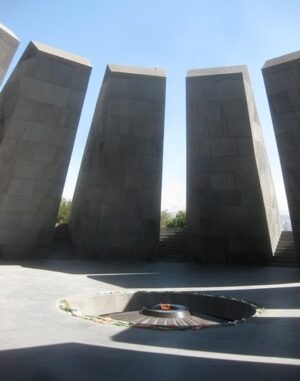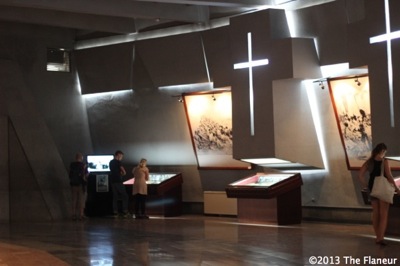
You can get an indication of how we view different countries by typing their names into Google. The automatic suggestions it makes to finish your query are illuminating. When you type England into the search engine you are given the suggestion of fixtures, as though the country is obsessed by sport. Typing Italy gives holidays… Typing Armenia however gives a very different result. The suggestion Google makes is genocide. It is not that Armenia does not have sporting fixtures and is not a holiday destination, but it has suffered in a way that most nations have not, and that remains a defining feature of the country.

At Tsitsernakaberd in the capital city of Yerevan there is a memorial to the victims and an eternal flame burning inside 12 large slabs. These represent the 12 provinces of old Armenia that now are within modern day Turkey. Every 24th April Armenians congregate here to remember those killed in 1915.
The causes are complicated and the Ottoman motives are disputed. The facts appear to be that in World War One Armenia was part of the Ottoman Empire, with 60,000 Armenians joining the Ottoman fight against the Allies. The Armenians were however the only large Christian group in the Empire, and after the Christian Russians dealt the Empire a heavy defeat in 1915 the Ottoman leaders saw the Armenians as an internal threat – as they could be potential supporters of the Russians.
In February 1915 the Armenian soldiers in the Ottoman army were moved from the army into labour groups. By April they had been killed. Other Armenians were force-marched into the Syrian desert and either left to starve or massacred. Between 1 and 1.5 million Armenians are thought to have died. Turkey, modern day successor of the Ottoman Empire acknowledges that many Armenians died, but says that the killings were not centrally orchestrated and so are not genocide.
The Genocide Museum in Yerevan has been open since 1995 and shows the Armenian view of events with horrific clarity. Photography existed and there are many appalling black and white images of mass burials and executions, some of which have been enlarged and printed poster-size on the walls. There is one particularly disturbing photo that is incomprehensible – until you realise that what seems to be soldiers posing behind a kneeling man who has two heads, is in fact soldiers posing behind a table cloth on which are two decapitated heads.

The main room of the museum is deliberately darkened, with crosses of light above glass-topped display cabinets. This is not an interactive, child-friendly museum but a repository of information, laid out as a series of horizontal displays, mostly showing booklets, documents and books.
Much of the space is given over to eye-witness accounts, memoirs and contemporary journals from people who were present. There are telegrams from US ambassadors, speeches from British politicians, newspaper articles and images. Given the Turkish opinion of events the museum is not just trying to show what happened, but aiming to provide evidence that it did happen.
Many countries and organisations, including the European Parliament, have acknowledged the massacres to have been a deliberate genocide, However some, including the UK and the US have not done so, the UK believing (as of 2013) that the 1948 UN Convention on Genocide should not be applied retroactively and not finding the massacres qualified enough to call them genocide. Campaigns continue for the UK to officially recognise the Armenian Massacres as a genocide.

Leave a Reply